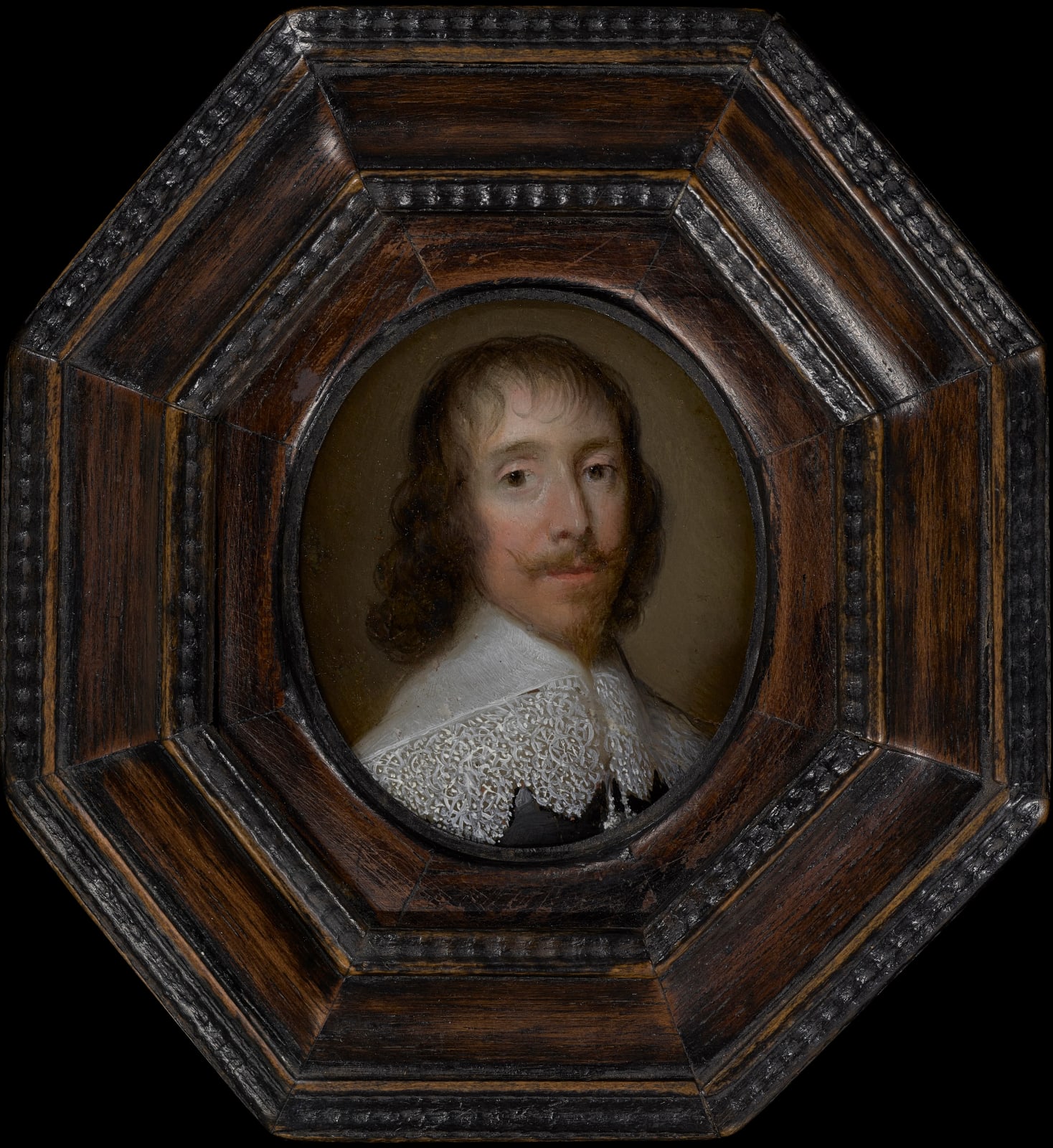Cornelius Johnson (1593 – 1661)
Provenance
Dr Yvonne Hackenbroch (1912 – 2012), London; from whom acquired by
Private collection, The Netherlands.
Every detail is exquisitely realised, from the carefully articulated lace patterning within the fallen collar to his softly falling hair.[1]
In his 1932 article concerning Johnson’s miniatures – the first of its kind - the art historian Ralph Edwards noted that, “The miniatures…are silvery and low in tone with transparent shadows, the carmines foiled by subtly graduated blues and greys. The modelling is sensitive, particularly round the mouth and eyes, and the hair is painted with a peculiar melting touch.”[2] Edwards, by his own estimation, had seen some twenty examples of Johnson’s portraits in little, probably more than anyone else by 1932, and perhaps even since. It is not clear whether he was aware of this miniature, but his lyrical descriptions of the artist’s tone, colouring, and technique all ring true to its distinctive aesthetic. Indeed, Johnson was of such accomplishment with oils on a small scale, especially compared with the more common practice of limning, that his works “attribute themselves”.[3] His skills were undoubtedly best suited to the intimacy of the bust-length portrait and the confines of the miniature.
In 1706, the British writer Bainbrigg Buckeridge described Johnson as ‘an excellent Painter both in great and little’.[4] Karen Hearn observes that Johnson’s miniatures share many qualities with his easel portraits – a refined technique, and a detailed rendition of costume, especially lace. She points out, and speculates, that George Vertue was correct in his assumption that Johnson’s procedure was to paint an easel portrait first, often followed by a miniature afterwards.[5] Certainly, numerous examples exist of sitters painted in both formats, with the miniature acting as a kind of ricordo. At present, it has not been possible to positively associate the miniature with an extant easel portrait, thus making it more difficult to identify our sitter, especially on account of their ‘cavalier’ appearance – i.e. long hair and pointed facial hair – it being a common fashion amongst men of the period. It is notable that our sitter bears a palpable resemblance to Charles I and, indeed, it is thought that Johnson did paint a miniature, upon a silver support, of the monarch in 1630.[6] Whilst our sitter clearly pays homage to the king’s grooming style, the relatively plain feeling of the portrait’s concept lacks the pomp one would expect for a portrait of a reigning monarch.[7]
~
Cornelius Johnson was the British-born son of Dutch émigrés in London, though his great-grandfather haled from Cologne. In 1622, when he married Elizabeth Beck (or Beek), herself from a Dutch migrant family based in Colchester, he was living in the London parish of St Ann, Blackfriars. Blackfriars was popular with immigrant craftsmen of many different trades, because it was outside the jurisdiction of the guilds of the City of London. Johnson would therefore have been part of a mutually supportive incomer community there. Throughout the 1620s, Johnson was clearly extremely busy, producing portraits for an increasingly important client base. He must have begun to run a workshop, with assistants, although we know nothing about how this operated.[8]
On 5 December 1632 Johnson was appointed Charles I’s ‘servant in ye quality of Picture Drawer’, and the king seems to predominantly used Johnson to make small-scale royal portraits, either on wooden panel or in his speciality medium, oil on copper, occasionally even including miniature copies after Van Dyck’s images. Indeed, earlier the same year, Anthony van Dyck had arrived in London and had begun to work for Charles I, who had knighted him on 5 July, and had appointed him ‘principalle Paynter in Ordinary to their Majesties’. As Charles’s official painter, van Dyck was, of course, expected to settle there. However socially and professionally ambitious Johnson may have been, the overwhelming success of Van Dyck must have presented him with a considerable challenge. Indeed, later in the 1630s, Johnson can sometimes be seen discreetly adopting and adapting van Dyckian compositions and postures in his own work.
Van Dyck died in December 1641, which should have re-opened opportunities for the artists in London whom he had elbowed aside. However, the political situation was deteriorating, and the King and Court left London early in 1642. In October 1643 Johnson and his family emigrated to the northern Netherlands, where his career had a second blossoming, as a leading portrait painter until his death in Utrecht in 1661. Twelve people carried his coffin, indicating his final wealth and status.
[1] Karen Hearn notes that in Johnson’s miniatures there is often ‘a gleam to the tip of the nose’, in “The Small Oil Colour Pictures of Cornelius Johnson (1593 – 1661)” from Portrait Miniatures, Artists, Functions & Collections, The Tansey Miniatures Foundation, London 2018, p. 180.
[2] R. Edwards, “Oil Miniatures by Cornelius Johnson” from The Burlington Magazine, Vol. 61 (September 1932), p. 132.
[3] R. Edwards, “Correspondence: Cornelius Johnson’s Miniatures” from Country Life, Vol. 82, no. 2113 (17 July 1937), p. xxxvi.[4] See K. Hearn, 2018, ibid., p. 179.
[5] See K. Hearn, ibid., p. 183 – 184.
[6] K. Hearn, Cornelius Johnson, London 2015, p. 46.
[7] A plausible candidate could be Thomas Bruce, 1st Earl of Elgin (1599 – 1663), whose portrait was painted by Johnson, in full-length, in 1638 (The Suffolk Collection at Kenwood House, London). His Stuart-like eye sockets and beard bear comparison, though his hair is more voluminous that our sitter’s.
[8] In January 1625, Johnson took on John Evoms.as an apprentice, and in April 1638 another (unnamed) apprentice joined him. According to George Vertue, Johnson’s nephew Theodore Roussel worked with him for nine years; see Hearn 2015, op. cit., pp.17, 18, 45.
